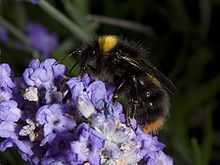Early bumblebee
| Early bumblebee | |
|---|---|
 | |
| B. pratorum pollinating | |
| Scientific classification | |
| Kingdom: | Animalia |
| Phylum: | Arthropoda |
| Class: | Insecta |
| Order: | Hymenoptera |
| Family: | Apidae |
| Subfamily: | Apinae |
| Genus: | Bombus |
| Subgenus: | Pyrobombus |
| Species: | B. pratorum |
| Binomial name | |
| Bombus pratorum (Linnaeus, 1761) | |
The early bumblebee or early-nesting bumblebee (Bombus pratorum) is a small bumblebee with a wide distribution in most of Europe and parts of Asia.
.jpg)
Description
The queen is black with a yellow collar (the band around the front of the thorax), another yellow band on the first tergite (abdominal segment), and red colouration on the tail (terga 5 and 6). The male has a wider yellow collar, yellow colouration on both terga 1 and 2, and a red tail, also. The workers are similar to the queen, but often with less yellow colouration; usually the abdominal, yellow band is more or less missing. The head of the bumblebee is rounded, and the proboscis is short.[1] The bumblebee is quite small; the queen has a body length of 15–17 mm (0.59–0.67 in), the worker 10–14 mm (0.39–0.55 in), and the male 11–13 mm (0.43–0.51 in).[2]
Flight period
It flies early (hence its name), usually from March to July, but in milder climates, as parts of southern England, it can appear as early as February.[1] However, the large earth bumblebee is normally even earlier.[3]
Habitat
Its habitat is very wide ranging, including fields, parks, scrubland, and sparse forest.[4]
Distribution
It is found in most of Europe, from the Arctic to the Mediterranean. It is, however, uncommon in the south of the Iberian Peninsula, Italy, and the Balkans. On the steppes of southern Russia and Ukraine, it is totally absent. In Asia, it is found in the mountains of northern Turkey, northern Iran, and uncommonly in Siberia west of the Yenisei River.[5]
It is common in most of the mainland United Kingdom, but less so in north-west of Scotland. It is absent from most Scottish islands, Orkney, and Shetland.[1]
Behaviour
A second generation is common in warmer climates (as most of England; in Scotland the species usually has only one brood yearly), often established in existing, but declining nests. Colonies rarely contain more than 100 individuals. It is a pollen storer, that is, it stores pollen in wax pots or empty cells and feeds each larva individually, rather than storing the pollen in pockets in the larval cells.[1]
It feeds on flowering plants with short corollae, as white clover, thistles, sage, lavender, Asteraceae, cotoneaster, and Allium.[2]
References
- ↑ 1.0 1.1 1.2 1.3 Benton, Ted (2006). "Chapter 9: The British Species". Bumblebees. London, UK: HarperCollins Publishers. pp. 338–342. ISBN 0007174519.
- ↑ 2.0 2.1 "Bombus pratorum, the Early bumblebee". Bumblebee.org. Retrieved 2013-01-24.
- ↑ Bombus pratorum The Garden Safari
- ↑ "Kleine Wald- bzw. Wiesenhummel - Bombus pratorum" (in German). Wildbienen.de. Retrieved 2013-01-24.
- ↑ Pierre Rasmont. "Bombus (Pyrobombus) pratorum (L., 1761)". Université de Mons. Retrieved 24 January 2013.
| Wikispecies has information related to: Bombus pratorum |
| Wikimedia Commons has media related to Bombus pratorum. |